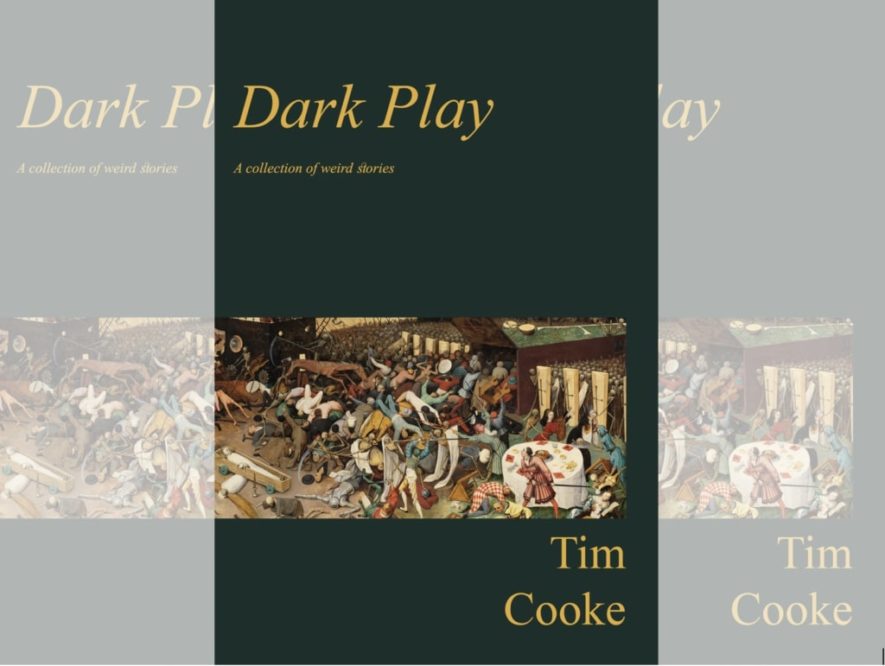Book review: Dark Play by Tim Cooke

Niall Griffiths is engrossed and intrigued by a debut collection of stories full of deep oddness.
Rural noir, folk horror, the new weird: constrained by word count here, I’d advise you to consult Wikipedia. And besides, potted biographies of genre only really serve to portray how porous and mutable they are, with each biographer differing in their opinion as to what works of art conform to their notion of what constitutes the genre.
There has, undoubtedly, been a flourishing of work within, and appreciation of, the three fields referred to in the opening of this paragraph, but let’s examine Tim Cooke’s stories outwith such genericisms (or mostly, anyway).
What this collection does brilliantly is to rupture the diurnal; to show the deep oddness at the heart of domesticity, and, especially, at the core of parenthood (who is this being that I have brought into the world? This disparate, demanding, often unreachable extension of myself with its own simultaneous autonomy?).
Ramsey Campbell is the master at this – what might be called, with apologies to Jason Solomon, the Noonday Demon – and Cooke is a worthy acolyte.
Gaping abyss
The absence of the mother is, throughout, a gaping abyss, until, at the last, in the titular story, we see her (an intriguing chronological inversion, this; what has happened to her in the preceding stories? Where will she go, where has she gone?), even as the daughter, a mighty presence so far, physically disappears.
The parental panic of loss here is well captured: ‘I dropped to my knees at the foot of an old ash tree and covered my face with my hands. I couldn’t stop thinking of the violence people are capable of…[I] started to run, praying under my breath’.
The amorphous shapes formed on the backs of the lids of squeezed-shut eyes are a recurring motif and I don’t really understand why, but it’s appropriately haunting.
Otherworldly
We are in an isolated farmhouse with a man with a fondness for mild intoxicants (and a hinted-at darker past) and an otherworldly, ‘attuned’ little daughter. As mentioned, there is no mother: ‘[The house] was too big for us now….We fetched a blanket and curled up on the sofa together, reading stories and talking about her mother, which she liked to do before bed’.
Past events of sideways horror intrude on the present. Rusting machinery is scattered across the mountainside. There is a forebodingness of mood. Cairns and hillforts and tumuli. The imagery is of rot, parasitism: flowers bloom like pustules, sheep are ‘strewn like ticks over the pasture below’.
There is a man seen in visions, a man with reindeer horns, an image which echoes and recurs (as in ‘Mother’, when Bethan appears, frantic, with ‘twigs and leaves knotted in her hair’). Reflections, concatenations; the land itself ‘seemed to shake’. Reality slips.
Intrigue
There is much going on in this little book, these stories. They engross and intrigue. Each one is preceded by a hallucinatory, horrific flashback, a brief vignette talking of murder, retribution, shrivings; it reads as if certain histories are outraged at being forgotten and must intrude into the present, must insist, violently if necessary, on being acknowledged.
The layers are multiple and re-readings are rewarded. Even the epigraph, from Schechner’s The Future of Ritual, examining the idea of ‘Dark Play’, is fascinating food for thought. The artefact itself is quite beautiful, too; the people at Salo Press have done a good job. Highly recommended.
Dark Play by Tim Cooke is published by Salo Press
Support our Nation today
For the price of a cup of coffee a month you can help us create an independent, not-for-profit, national news service for the people of Wales, by the people of Wales.




